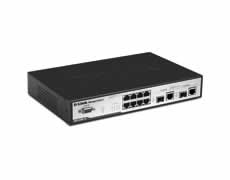D-Link DGS-3200-10 Managed L2 Switch
D-Link Updated: 2008-10-06 RSS
The DGS-3200-10 Managed Gigabit Switch offers a new generation of intelligence and defense with high-performance, flexibility, and robust security. This switch secures your network from viruses using its ACL, IMPB (IP-MAC-Port Binding) and Safeguard Engine functions. The DGS-3200-10 is a compact switch built with a fan-less technology to emit less heat and noise than standard switches. With its 11" footprint, the DGS-3200-10 is ideal for any office environment with limited space.
Comprehensive Security
The DGS-3200-10 offers a complete list of endpoint security features, bringing confidence and assurance to your network. It executes firm network security and comes with user-based identity control by implementing host-based 802.1x authentication/authorization, along with clientless Web-based Access Control (WAC) and MAC-based Access Control (MAC) for easy deployment. The incorporation of sophisticated ACL user-defined functionality secures your network against viruses and worms while innovative IP-MAC-Port Binding prevents ARP spoofing and man-in-middle attacks by recognizing malicious users who falsify their IP or MAC address, assuring administrators that the IP information on the syslog server or firewall log is always correct. Other security features like port security and traffic segmentation provide granular control to business environments, allowing administrators to enhance network security.
For clients with Windows® XP SP3, Windows Vista®, or servers with Windows Server 2008, the DGS-3200-10 works in conjunction with the Microsoft® Network Access Protection (NAP) as part of an ecosystem that enforces compliance with network health policies. The switch will grant network host access only if it complies with IT security policies such as up-to-date anti-virus signatures and operating system patches. This prevents an infected client or server from gaining access and further contaminating the network. D-Link combines NAP with the D-Link® ZoneDefense™ technology for joint security that provides admission control and real-time defense. The D-Link ZoneDefense technology allows businesses to integrate the switch with D-Link NetDefend™ firewall to implement full coverage with a proactive security architecture.
IPv6 and IPv4 Technology
The DGS-3200-10 provides current IPv4 networks with a simple migration path to IPv6 and protects your investment for future network upgrades when greater security and larger addressing are required. The IPv6 multicast host, the latest in protocol technology, enables maximum hardware performance. MLD snooping enhances efficiency in selective distribution by forwarding multicast data to receiving ports, rather than flooding all ports in a VLAN. Features such as ACL based on IPv6 flow label and traffic class, as well as QoS-based on IPv6 help provide faster and an efficient service. IPv6 Management supports Web, telnet and SNMP.
Reliance/Performance Enhancement
To enhance network resilience, the DGS-3200-10 provides Spanning Tree protocols including 802.1D, 802.1w, and 802.1s for redundant bridge paths. Link Aggregation provides aggregated bandwidth between switches or servers to increase redundancy for higher availability. Quality of Service (QoS) incorporates multilayer functions that support 8 queues including 802.1p priority and packet classification based on TOS, DSCP, MAC, IP, VLAN ID and L4 TCP/UDP ports, enabling Internet voice, video and streaming media applications to run smoothly. The switch also provides a Safeguard Engine for network protection to increase the switch's reliability, serviceability and availability.
Traffic Control
Network administrators can define throughput levels for each port to allocate its essential bandwidth. Broadcast storm control and flow-based bandwidth control can reduce the level of damage from virus attacks or P2P applications to the network.
Single IP Management
To simplify and speed up your management tasks, multiple switches can be configured, monitored and maintained from any workstation running a web browser through one, unique IP address. This virtual stack is managed as a single object, having all units maintained by one IP address. Up to 32 D-Link switches, each supporting Single IP Management, can be managed under a single IP Address.
Owners Manual
Data Sheet
Related Manuals
D-Link DES-3550 Managed Stackable L2 Switch
D-Link DXS-3250 Gigabit Wireless-Ready Switch
D-Link DGS-3024 Switch
D-Link DGS-3224TGR Switch
D-Link DGS-3048 Switch
D-Link DGS-3612G xStack Managed Gigabit SFP Standalone Switch
D-Link DGS-3627 xStack Managed Gigabit Stackable Switch
D-Link DGS-3627G xStack Managed Gigabit SFP Stackable Switch
D-Link DGS-3650 xStack Managed Gigabit Stackable Switch
D-Link DGS-3324SR Switch
D-Link DGS-3324SRi Switch
D-Link DXS-3326GSR SFP Switch